Austin Mounted Patrol Making Most of New Home
By Pamela Hall Vance
Reporting Texas
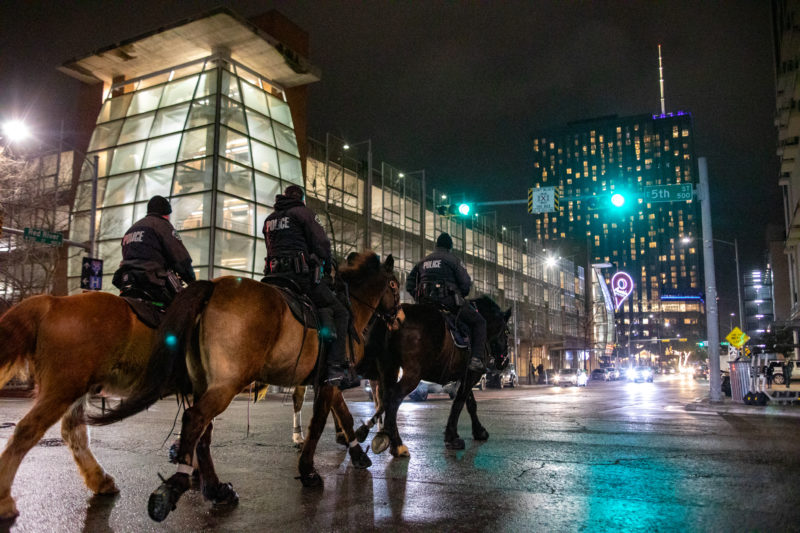
The Austin Police Mounted Unit patrol team crosses Sixth Street during the Mardi Gras Bar Crawl in Austin, Texas, on Feb. 26, 2022. Alyssa Olvera/Reporting Texas
Like many Central Texas residents, Austin police officer Dawn Leonard has bad memories from Winter Storm Uri in 2021. Not only did she have to keep herself warm, but she had to ensure the survival of the horses of the Austin Police Department’s mounted patrol unit.
“It was a horrible week,” Leonard said. “So 24/7, every two hours, I got up and scooped poop.”
In the end, the storm turned out to be a blessing for the 16 horses in the mounted patrol unit. Because of a lack of water and sewer issues caused by the storm, the Austin Police Department moved the animals from a stable in Manor to the Austin Equestrian Center in Cedar Creek.
“Once the storm was done … we realized that we had broken pipes,” Leonard said. “It was not habitable for officers or horses. … We had sewage leaking into some back stalls.”

Austin police officer Dawn Leonard cleans Breezy’s hooves at the equestrian center in Cedar Creek, Texas, where the mounted patrol unit’s horses are now housed. Alyssa Olvera/Reporting Texas
In March 2021, the city leased the 62-acre equestrian center in Cedar Creek, which provided the horses more space where they could thrive, Leonard said. The new home soon became permanent. In February 2022, the Austin City Council voted to approve the purchase of the facility for $1.8 million.
“We’ve been waiting 36 years for a facility that we don’t lease. And we finally are here,” Leonard said.
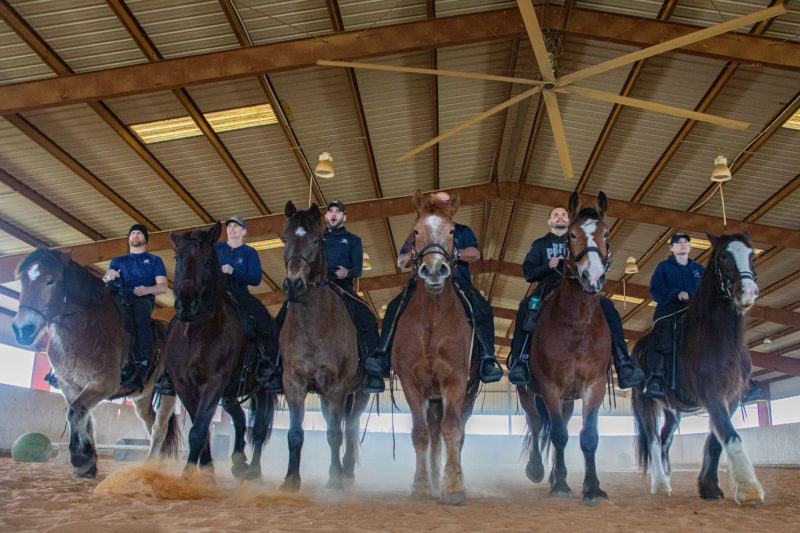
Austin police officers finish up formation practice at the mounted unit’s new facilities in Cedar Park, Texas. Alyssa Olvera/Reporting Texas
Every Wednesday, both day and night shifts of the APD Mounted Patrol Unit meet up for training at the equestrian center. In addition to their equitation or horsemanship exercises to improve their relationship with the horses, they practice the tactical line formations that they will use when they patrol downtown Austin.
New officers go through an eight-week mounted school at the equestrian center. They must serve at least four years as a police officer before they can join the unit. No prior horse training is necessary.
“You don’t have to have any riding experience. We actually kind of prefer you don’t — as long as you’re not afraid of horses — because it’s easier to teach you than it is to get you to unlearn bad habits and relearn,” Leonard said.
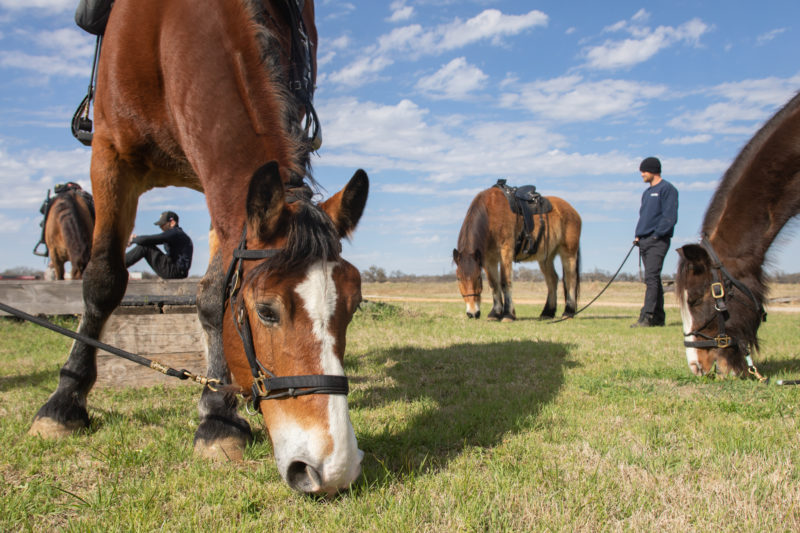
Austin police officers watch as their horses graze at the equestrian center. Officers who join the unit not only learn how to ride horses but how to care for them as well. Alyssa Olvera/Reporting Texas
Officers interested in joining the unit are encouraged to come to the equestrian center to see how physically intensive it is. A lot of care and upkeep of the horse, barn and equipment is involved, Leonard said. “It’s not just get on and ride a horse.”
While on patrol, officers have to deal with heat and cold, Leonard added. “We don’t get to sit in a car, like when you are on patrol. We have to be out in the elements.”
The weather was the worst part of the job for Sgt. Julie Payne. “But you learn how to deal with it,” Payne said.
The APD Mounted Patrol Unit was started in 1986 with donations from downtown businesses, but the unit is now completely funded by the city of Austin, Payne said. The mission today is the same as it was back then: search and rescue, patrols, community events and crowd control.
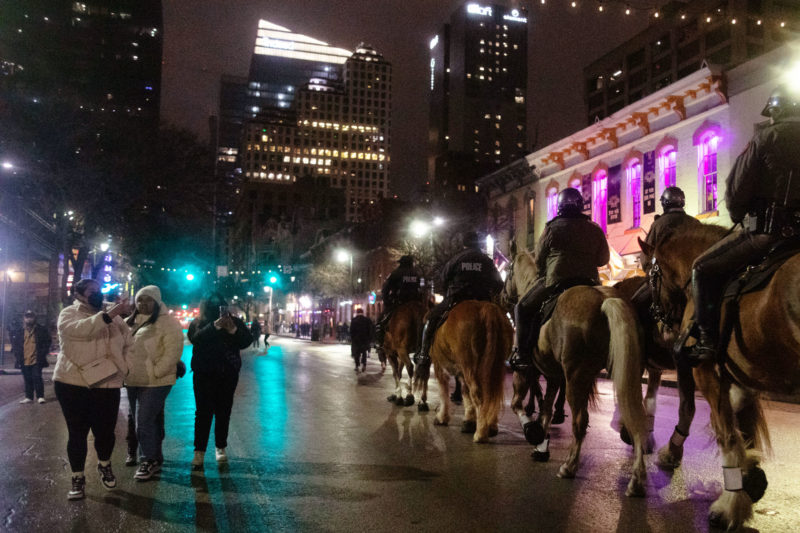
Although the mounted unit has come under criticism from several Austin City Council members, police countered that it is a good tool to move crowds with little force. Alyssa Olvera/Reporting Texas
The unit has faced criticism. In 2020, several Austin City Council members proposed eliminating or restructuring the unit in their 2021 budget proposals. Former council member Jimmy Flannigan has said that it doesn’t appear to be a particularly valuable or useful tool.
In the face of the criticism, Payne credits the APD executive staff with recognizing the patrol’s usefulness and helping them keep the funding. She calls the unit a “staffing multiplier” and says that one well-trained officer on a well-trained horse is equal to 10 officers on foot.
“There came a point during the protests, that our mounted unit was very effective,” Payne said. “We can move a crowd … with very little use of force.”
In addition to crowd control during protests, the mounted unit performs search-and-rescue missions as needed.
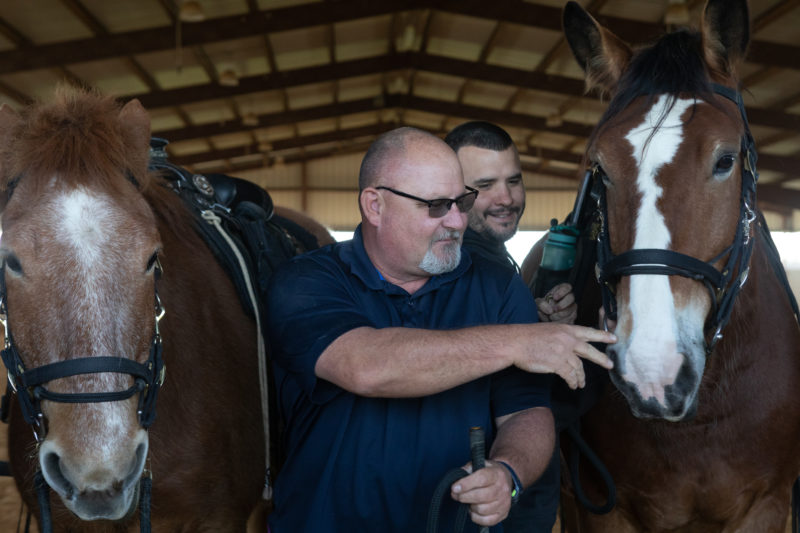
Austin police officer Charles Bethel tends to his horse after formation practice. Alyssa Olvera/Reporting Texas
“We use their senses when we do search and rescue if we have to go out and look for … somebody lost … because they can hear things that we don’t, ” said officer Charles Bethel. “If they’re stopping and looking over somewhere, then we will go that direction to look and see if we find anybody.”
Community relations are important to the mounted patrol unit.
They have started an equine therapy program and have a volunteer program, which has been successful. Payne said: “We partnered with the Bastrop Independent School District and a lot of our volunteers are the kids and the parents. Actually we’ve had a lot more parents coming out.”
“I believe the horse is a valuable tool for building a bridge between the community and police officers, because people will walk up to us when they wouldn’t walk up to an officer in a car,” Payne said.